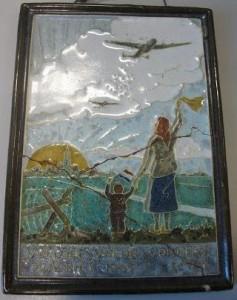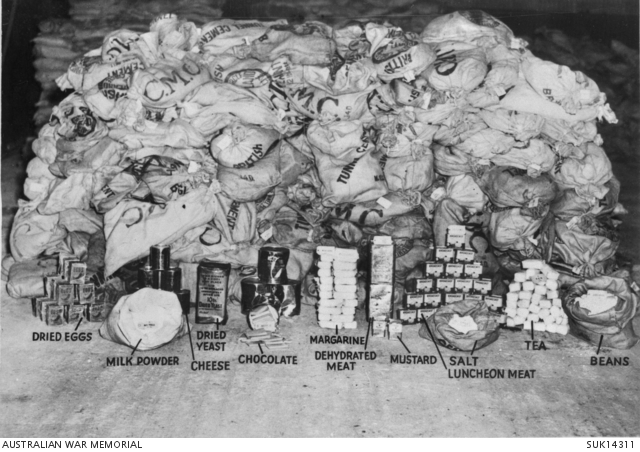Food from Heaven - 460 Squadron and Operation Manna, 1945
65 years ago a very special operation began to provide food to the starving civilians in the German occupied Netherlands. During the harsh winter of 1944-1945 the Dutch population endured a major famine. Known as the ‘hungerwinter’ it was concentrated in the densely populated urban areas bounded by Amsterdam, Utrecht, Rotterdam and The Hague. By 1945 the daily ration had been reduced to 600 calories – a third of what it had been in 1941.
On 29 April 1945, RAF aircraft took off from England to take part in the first of several missions to drop food to the starving Dutch. The British poetically named this mission ‘Operation Manna’, in reference to the ‘food from heaven’ in the Bible. The Americans began their food drops from 1 May, calling their involvement ‘Operation Chowhound’.
Although the operation began on 29 April, negotiations with the Germans to allow Allied aircraft to fly over their occupied territories was not finalised or signed until 2 May. Despite this the early missions successfully flew over German occupied territories and dropped their cargo.
On 30 April, the RAAF also became involved, with 21 aircraft from 460 Squadron setting out on the first of seven food drops over the Netherlands. The first plane took off at 2.24 pm, dropping its load over The Hague at 4.15 pm. In only seven minutes, these 21 aircraft dropped a combined total of over 50,000 kilograms of food from only 150 metres above the city!
For some air crew, it was a change from the destructive bombing missions over Germany and occupied Europe. For others it was their only opportunity to take part in an operational mission. Near the end of the war, air crew numbers were high but there was not enough aircraft available for them.
The format of the Manna flights were very different from the normal bombing missions. The aircraft had to fly within designated areas and at low altitudes. They were within easy reach of any German weapons, including small arms. The German soldiers had instructions not to shoot the aircraft flying within the designated zones (although it occasionally did occur, there were no fatalities as a result of the arms fire).

The aircraft flew at such low levels because the amount of silk required to make parachutes for the food parcels was unavailable. The parcels were crammed into bomb bays and held in place during flight by the aircraft’s hydraulics. To disperse the supplies, the Bomb Aimer simply opened the bomb doors and free dropped the food over the designated area.
The food parcels were not aerodynamic, and their dispersal often caused dents in the leading edges of the tail plane and fins when they collided with the rear of the aircraft (causing the rear gunners to instinctively shrink out of the way as the supplies whizzed around them!).

For their own safety, the local population were instructed to remain indoors during the food drops, but many were too excited to follow the instructions; air crew reported seeing people outside, cheering and waving as they flew past. Although the supplies generally landed in the designated area (often a field or sports oval), sometimes they were dropped too soon or too late. In some instances parcels damaged buildings, and in some very unfortunate incidents, civilians were killed when they were hit by falling food parcels.
The final Manna run by 460 Squadron, on 7 May 1945 was also the largest for the squadron, with twenty eight aircraft taking part. With the end of the war in Europe on 8 May, Operation Manna concluded. Further food supplies were brought in by land. Although the situation in the Netherlands was still extremely difficult, Operation Manna provided a major morale boost for the occupied nation.
Over 340,000 kilograms of food in total was dropped over the Netherlands by 460 Squadron alone, which would have been enough to feed 400,000 people for one day.
| Date | Number of aircraft | load per aircraft (pounds) | Approx Load per aircraft (kilograms) | total load for mission (pounds) | Approx total load for mission (kilograms) | Dropping zone |
| 30/4 | 21 | 5739 lbs | 2603 kg | 120,519 lbs | 54,666 kg | The Hague |
| 1/5 | 23 | 5739 lbs | 2603 kg | 131,997 lbs | 59,872kg | Rotterdam Area |
| 2/5 | 23 | 5310 lbs | 2408 kg | 122,130 lbs | 55,397 kg | Rotterdam Area |
| 3/5 | 24 | 5310 lbs | 2408 kg | 127,440 lbs | 57,805 kg | Rotterdam Area |
| 4/5 | 10 | 5310 lbs | 2408 kg | 53,100 lbs | 24,085 kg | Rotterdam Area |
| 5/5 | 10 | 5310 lbs | 2408 kg | 53,100 lbs | 24,085 kg | Leiden Airfield |
| 7/5 | 28 | 5310 lbs | 2408 kg | 148,680 lbs | 67,440 kg | Rotterdam Area |
| Total Aircraft | 139 | Total loads dropped | 756,966 lbs | 343,350 kg |
Further Reading:
- Operation Manna/Chowhound : the allied food droppings April/May 1945 / Hans Onderwater, Romen Luchtvaart, Unieboek, c 1985.
- AWM64 1/295 Operations Record Book No 460 Squadron RAAF January 1944 to October 1945
- The Hunger Winter: Occupied Holland 1944-1945 / Henri van der Zee, University of Nebraska Press, 1998


